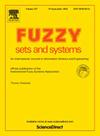Approximate bisimulations for Kripke models of fuzzy multimodal logics over complete Heyting algebras
IF 3.2
1区 数学
Q2 COMPUTER SCIENCE, THEORY & METHODS
引用次数: 0
Abstract
In this paper, we study two types of λ-approximate simulations and five types of λ-approximate bisimulations for Kripke models of fuzzy multimodal logics over complete Heyting algebras. The value λ is an element from a Heyting algebra, which serves to relax the conditions in the definitions of simulations and bisimulations. Additionally, λ represents the degree of modal equivalence between two worlds from distinct Kripke models, considering the given non-empty set of modal formulae. Further, we develop an efficient algorithm for computing the greatest λ-approximate simulation and bisimulation for every type. We also demonstrate the application of these algorithms in the state reduction of Kripke models in such a way that the reduced model preserves the same semantic properties to the extent determined by the scalar λ. We also present the algorithm that partitions the interval of the degrees of modal equivalence into subintervals with the same minimal corresponding factor fuzzy Kripke model.
模糊多模态逻辑的Kripke模型在完全Heyting代数上的近似双模拟
本文研究了完全Heyting代数上模糊多模态逻辑的Kripke模型的两类λ-近似模拟和五类λ-近似双模拟。λ值是Heyting代数中的一个元素,用于放宽仿真和双仿真定义中的条件。此外,考虑到给定的非空模态公式集,λ表示来自不同Kripke模型的两个世界之间的模态等效程度。此外,我们还开发了一种有效的算法来计算每种类型的最大λ近似模拟和双模拟。我们还演示了这些算法在Kripke模型的状态约简中的应用,使约简模型在标量λ确定的程度上保留了相同的语义属性。给出了用相同最小对应因子模糊Kripke模型将模态等价度区间划分为子区间的算法。
本文章由计算机程序翻译,如有差异,请以英文原文为准。
求助全文
约1分钟内获得全文
求助全文
来源期刊

Fuzzy Sets and Systems
数学-计算机:理论方法
CiteScore
6.50
自引率
17.90%
发文量
321
审稿时长
6.1 months
期刊介绍:
Since its launching in 1978, the journal Fuzzy Sets and Systems has been devoted to the international advancement of the theory and application of fuzzy sets and systems. The theory of fuzzy sets now encompasses a well organized corpus of basic notions including (and not restricted to) aggregation operations, a generalized theory of relations, specific measures of information content, a calculus of fuzzy numbers. Fuzzy sets are also the cornerstone of a non-additive uncertainty theory, namely possibility theory, and of a versatile tool for both linguistic and numerical modeling: fuzzy rule-based systems. Numerous works now combine fuzzy concepts with other scientific disciplines as well as modern technologies.
In mathematics fuzzy sets have triggered new research topics in connection with category theory, topology, algebra, analysis. Fuzzy sets are also part of a recent trend in the study of generalized measures and integrals, and are combined with statistical methods. Furthermore, fuzzy sets have strong logical underpinnings in the tradition of many-valued logics.
 求助内容:
求助内容: 应助结果提醒方式:
应助结果提醒方式:


